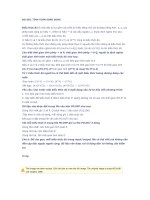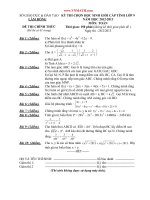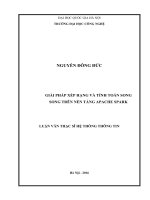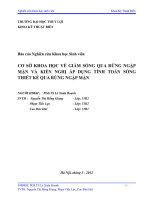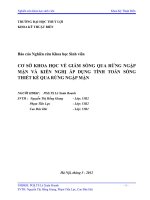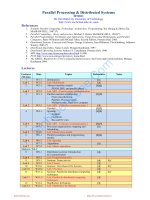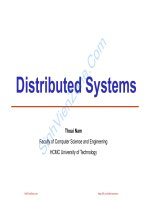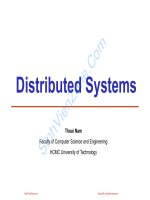tính toán song song thoại nam distributedsystem 18 mapreduce sinhvienzone com
Bạn đang xem bản rút gọn của tài liệu. Xem và tải ngay bản đầy đủ của tài liệu tại đây (479.31 KB, 31 trang )
om
.C
ne
nh
Vi
en
Zo
MapReduce
Si
Nguyen Quang Hung
SinhVienZone.com
/>
Objectives
nh
Vi
en
Zo
ne
.C
om
This slides is used to introduce students about
MapReduce framework: programming model and
implementation.
Si
SinhVienZone.com
/>
.C
ne
Zo
nh
Vi
en
Challenges
Motivation
Ideas
Programming model
Implementation
Related works
References
Si
om
Outline
SinhVienZone.com
/>
Introduction
om
Challenges?
nh
Vi
en
Zo
ne
.C
– Applications face with large-scale of data (e.g. multi-terabyte).
» High Energy Physics (HEP) and Astronomy.
» Earth climate weather forecasts.
» Gene databases.
» Index of all Internet web pages (in-house).
» etc
– Easy programming to non-CS scientists (e.g. biologists)
Si
SinhVienZone.com
/>
MapReduce
om
Motivation: Large scale data processing
nh
Vi
en
Zo
ne
.C
– Want to process huge of datasets (>1 TB).
– Want to parallelize across hundreds/thousands of CPUs.
– Want to make this easy.
Si
SinhVienZone.com
/>
MapReduce: ideas
om
.C
ne
Zo
nh
Vi
en
Automatic parallel and data distribution
Fault-tolerant
Provides status and monitoring tools
Clean abstraction for programmers
Si
SinhVienZone.com
/>
MapReduce: programming model
om
.C
ne
Zo
map (k1,v1) list(k2,v2)
reduce (k2,list(v2)) list(v2)
nh
Vi
en
Borrows from functional programming
Users implement interface of two functions: map and
reduce:
Si
SinhVienZone.com
/>
map() function
om
Records from the data source (lines out of files, rows of a
database, etc) are fed into the map function as key*value
pairs: e.g., (filename, line).
map() produces one or more intermediate values along
with an output key from the input.
Zo
nh
Vi
en
Si
ne
.C
SinhVienZone.com
/>
reduce() function
om
.C
ne
Zo
nh
Vi
en
After the map phase is over, all the intermediate values
for a given output key are combined together into a list
reduce() combines those intermediate values into one or
more final values for that same output key
(in practice, usually only one final value per key)
Si
SinhVienZone.com
/>
Parallelism
om
.C
ne
Zo
nh
Vi
en
map() functions run in parallel, creating different
intermediate values from different input data sets
reduce() functions also run in parallel, each working on a
different output key
All values are processed independently
Bottleneck: reduce phase can’t start until map phase is
completely finished.
Si
SinhVienZone.com
/>
Si
nh
Vi
en
Zo
ne
.C
om
MapReduce: execution flows
SinhVienZone.com
/>
Example: word counting
map(String input_key, String input_doc):
om
reduce(String output_key, Iterator
intermediate_values):
nh
Vi
en
Zo
ne
.C
// input_key: document name
// input_doc: document contents
for each word w in input_doc:
EmitIntermediate(w, "1"); // intermediate values
Si
// output_key: a word
// output_values: a list of counts
int result = 0;
for each v in intermediate_values:
result += ParseInt(v);
Emit(AsString(result));
More examples: Distributed Grep, Count of URL access frequency,
etc.
SinhVienZone.com
/>
Locality
om
Master program allocates tasks based on location of
data: tries to have map() tasks on same machine as
physical file data, or at least same rack (cluster rack)
map() task inputs are divided into 64 MB blocks: same
size as Google File System chunks
Zo
nh
Vi
en
Si
ne
.C
SinhVienZone.com
/>
Fault tolerance
Master detects worker failures
om
nh
Vi
en
Zo
Master notices particular input key/values cause crashes
in map(), and skips those values on re-execution.
Si
ne
.C
– Re-executes completed & in-progress map() tasks
– Re-executes in-progress reduce() tasks
SinhVienZone.com
/>
Optimizations (1)
No reduce can start until map is complete:
om
nh
Vi
en
Zo
ne
Master redundantly executes “slow-moving” map tasks;
uses results of first copy to finish
Si
.C
– A single slow disk controller can rate-limit the whole process
Why is it safe to redundantly execute map tasks? Wouldn’t this mess
up the total computation?
SinhVienZone.com
/>
Optimizations (2)
om
.C
ne
Zo
nh
Vi
en
“Combiner” functions can run on same machine as a
mapper
Causes a mini-reduce phase to occur before the real
reduce phase, to save bandwidth
Si
Under what conditions is it sound to use a combiner?
SinhVienZone.com
/>
.C
ne
Zo
nh
Vi
en
Google MapReduce: C/C++
Hadoop: Java
Phoenix: C/C++ multithread
Etc.
Si
om
MapReduce: implementations
SinhVienZone.com
/>
Google MapReduce evaluation (1)
om
nh
Vi
en
– Two-level tree-shaped switched network with approximately 100200 Gbps of aggregate bandwidth available at the root.
– Round-trip time any pair of machines: < 1 msec.
Si
Zo
ne
Cluster: approximately 1800 machines.
Each machine: 2x2GHz Intel Xeon processors with
Hyper-Threading enabled, 4GB of memory, two 160GB
IDE disks and a gigabit Ethernet link.
Network of cluster:
.C
SinhVienZone.com
/>
Si
nh
Vi
en
Zo
ne
.C
om
Google MapReduce evaluation (2)
Data transfer rates over time for different executions of the sort
program (J.Dean and S.Ghemawat shows in their paper [1, page 9])
SinhVienZone.com
/>
Si
nh
Vi
en
Zo
ne
.C
om
Google MapReduce evaluation (3)
J.Dean and S.Ghemawat shows in theirs paper [1]
SinhVienZone.com
/>
Related works
om
.C
ne
Zo
nh
Vi
en
Bulk Synchronous Programming [6]
MPI primitives [4]
Condor [5]
SAGA-MapReduce [8]
CGI-MapReduce [7]
Si
SinhVienZone.com
/>
Si
nh
Vi
en
Zo
ne
.C
om
SAGA-MapReduce
High-level control flow diagram for SAGA-MapReduce. SAGA uses a
master-worker paradigm to implement the MapReduce pattern. The
diagram shows that there are several different infrastructure options to
a SAGA based application [8]
SinhVienZone.com
/>
Si
nh
Vi
en
Zo
ne
.C
om
CGL-MapReduce
Components of the CGL-MapReduce , extracted from [8]
SinhVienZone.com
/>
Si
nh
Vi
en
Zo
ne
.C
om
CGL-MapReduce: sample
applications
MapReduce for HEP
SinhVienZone.com
MapReduce for Kmeans
/>
Si
nh
Vi
en
Zo
ne
.C
om
CGL-MapReduce: evaluation
HEP data analysis, execution
time vs. the volume of data
(fixed compute resources)
Total Kmeans time against the
number of data points (Both
axes are in log scale)
J.Ekanayake, S.Pallickara, and G.Fox show in their paper [7]
SinhVienZone.com
/>
